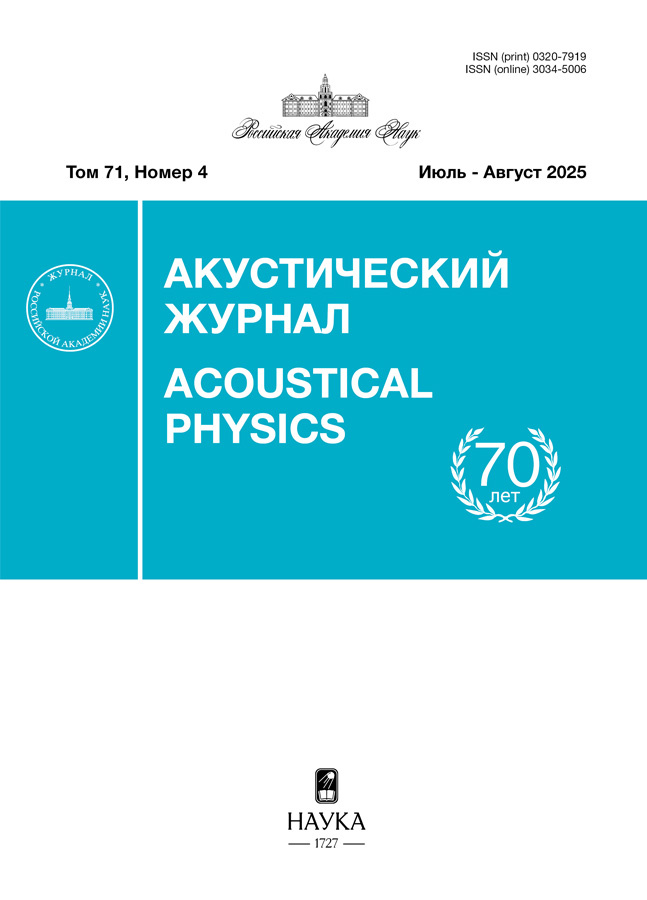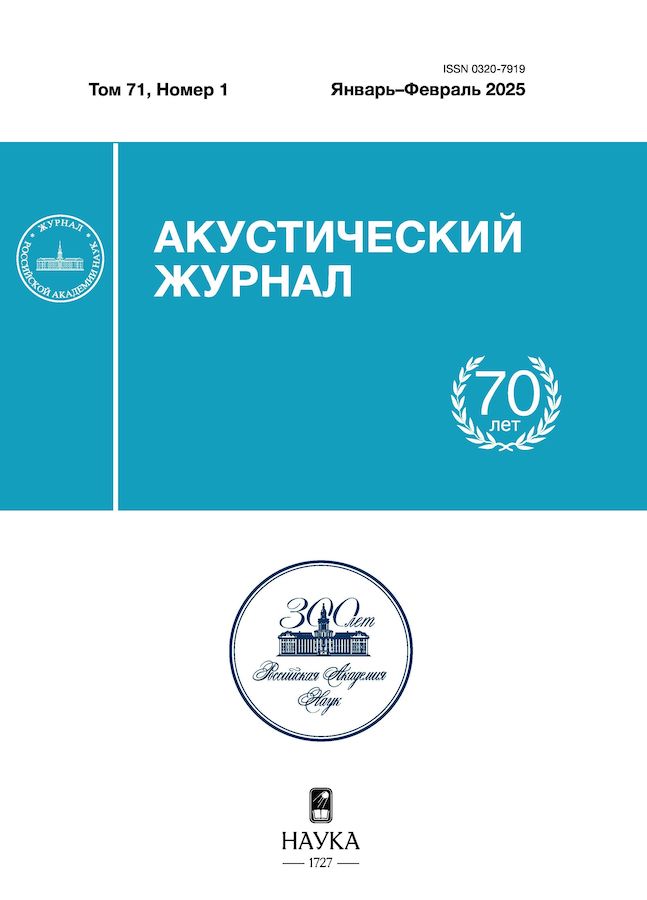Широкополосные низкочастотные излучатели в задачах исследования температурных режимов Японского моря
- Авторы: Боголюбов Б.Н.1, Бритенков А.К.1, Касьянов Д.А.1, Фарфель В.А.1, Моргунов Ю.Н.2, Безответных В.В.2, Войтенко Е.А.2, Голов А.А.2, Тагильцев А.А.2
-
Учреждения:
- Федеральное государственное бюджетное научное учреждение “Федеральный исследовательский центр Институт прикладной физики им. А.В. Гапонова-Грехова Российской академии наук” (ИПФ РАН)
- Федеральное государственное бюджетное учреждение науки Тихоокеанский океанологический институт им. В.И. Ильичева Дальневосточного отделения Российской академии наук (ТОИ ДВО РАН)
- Выпуск: Том 71, № 1 (2025)
- Страницы: 67-78
- Раздел: АКУСТИКА ОКЕАНА. ГИДРОАКУСТИКА
- URL: https://bulletin.ssaa.ru/0320-7919/article/view/683638
- DOI: https://doi.org/10.31857/S0320791925010085
- EDN: https://elibrary.ru/BQRVKV
- ID: 683638
Цитировать
Полный текст
Аннотация
Рассмотрено применение технических средств и методов низкочастотной гидроакустики для мониторинга изменчивости средних температур подводных звуковых каналов Японского моря. Проведен обзор характеристик линейки разработанных ИПФ РАН мощных гидроакустических излучателей, перспективных для организации протяженных акустических трасс. Приведены результаты измерений электроакустических характеристик низкочастотных гидроакустических излучателей в натурных условиях в эшелоне глубин до 150 м, а также рассмотрено применение указанных излучателей для исследования температурных режимов сопряженных подводных звуковых каналов шельфа и глубокого моря на разномасштабных протяженных трассах в Японском море. На основе обработки экспериментальных данных акустической трассы длиной около 1000 км, полученных в 2022 г., приведены примеры восстановления средних значений температуры воды по данным скорости звука на акустической трассе, проведена оценка чувствительности метода, а также проанализированы достигнутые в эксперименте значения отношения сигнал/шум.
Полный текст
Об авторах
Б. Н. Боголюбов
Федеральное государственное бюджетное научное учреждение “Федеральный исследовательский центр Институт прикладной физики им. А.В. Гапонова-Грехова Российской академии наук” (ИПФ РАН)
Email: golov_alexander@inbox.ru
Россия, ул. Ульянова 46, Нижний Новгород, 603950
А. К. Бритенков
Федеральное государственное бюджетное научное учреждение “Федеральный исследовательский центр Институт прикладной физики им. А.В. Гапонова-Грехова Российской академии наук” (ИПФ РАН)
Email: golov_alexander@inbox.ru
Россия, ул. Ульянова 46, Нижний Новгород, 603950
Д. А. Касьянов
Федеральное государственное бюджетное научное учреждение “Федеральный исследовательский центр Институт прикладной физики им. А.В. Гапонова-Грехова Российской академии наук” (ИПФ РАН)
Email: golov_alexander@inbox.ru
Россия, ул. Ульянова 46, Нижний Новгород, 603950
В. А. Фарфель
Федеральное государственное бюджетное научное учреждение “Федеральный исследовательский центр Институт прикладной физики им. А.В. Гапонова-Грехова Российской академии наук” (ИПФ РАН)
Email: golov_alexander@inbox.ru
Россия, ул. Ульянова 46, Нижний Новгород, 603950
Ю. Н. Моргунов
Федеральное государственное бюджетное учреждение науки Тихоокеанский океанологический институт им. В.И. Ильичева Дальневосточного отделения Российской академии наук (ТОИ ДВО РАН)
Email: golov_alexander@inbox.ru
Россия, улица Балтийская 43, Владивосток, 690041
В. В. Безответных
Федеральное государственное бюджетное учреждение науки Тихоокеанский океанологический институт им. В.И. Ильичева Дальневосточного отделения Российской академии наук (ТОИ ДВО РАН)
Email: golov_alexander@inbox.ru
Россия, улица Балтийская 43, Владивосток, 690041
Е. А. Войтенко
Федеральное государственное бюджетное учреждение науки Тихоокеанский океанологический институт им. В.И. Ильичева Дальневосточного отделения Российской академии наук (ТОИ ДВО РАН)
Email: golov_alexander@inbox.ru
Россия, улица Балтийская 43, Владивосток, 690041
А. А. Голов
Федеральное государственное бюджетное учреждение науки Тихоокеанский океанологический институт им. В.И. Ильичева Дальневосточного отделения Российской академии наук (ТОИ ДВО РАН)
Автор, ответственный за переписку.
Email: golov_alexander@inbox.ru
Россия, улица Балтийская 43, Владивосток, 690041
А. А. Тагильцев
Федеральное государственное бюджетное учреждение науки Тихоокеанский океанологический институт им. В.И. Ильичева Дальневосточного отделения Российской академии наук (ТОИ ДВО РАН)
Email: golov_alexander@inbox.ru
Россия, улица Балтийская 43, Владивосток, 690041
Список литературы
- Howe B.M., Anderson S.G., Baggeroer A.B., Colosi J.A., Hardy K.R., Horwitt D., Karig F.W., Leach S., Mercer J.A., Metzger K., et al. Instrumentation for the Acoustic Thermometry of Ocean Climate (ATOC) prototype Pacific Ocean network // Proc. Conference ‘Challenges of Our Changing Global Environment’. OCEANS’95 MTS/IEEE, San Diego, CA, USA, 9–12 October 1995. P. 1483–1500.
- Munk W. Acoustic thermometry of ocean climate (ATOC) // J. Acoust. Soc. Am. 1999. V. 105. № 2. Р. 982.
- Акуличев В.А., Безответных В.В., Буренин А.В., Войтенко Е.А., Моргунов Ю.Н. Эксперимент по оценке влияния вертикального профиля скорости звука в точке излучения на шельфе на формирование импульсной характеристики в глубоком море // Акуст. журн. 2010. Т. 56. № 1. С. 51–52.
- Безответных В.В., Буренин А.В., Войтенко Е.А., Моргунов Ю.Н. Оценки эффективной скорости распространения низкочастотных фазоманипулированных сигналов на протяженных трассах при сложных гидролого-акустических условиях и переменном рельефе дна // Подводные исследования и робототехника. 2008. № 2(6). С. 58–63. EDN KYIJWL
- Вировлянский А.Л., Казарова А.Ю., Любавин Л.Я. Восстановление средней температуры океана по измерениям времени пробега звуковых импульсов // Акуст. журн. 2007. Т. 53. № 2. С. 216–225.
- Зверев В.А., Голубев В.Н., Коротин П.И. Условия выделения лучей по времени их прихода на больших расстояниях и низких частотах //Акуст. журн. 2020. Т. 66. № 2. С. 163–169.
- Зверев В.А., Стромков А.А. Увеличение временной селекции сигналов, принимаемых по лучам при зондировании океана посредством М-последовательности // Акуст. журн. 2003. Т. 49. № 4. С. 514–518.
- Римский-Корсаков А.В. и др. Акустические подводные низкочастотные излучатели. Л.: Судостроение, 1984. 184 с.
- Morozov A.K. and Webb D.C. A Sound Projector for Acoustic Tomography and Global Ocean Monitoring // IEEE J. Oceanic Engineering. 2003. V. 28. No 2. P. 174-185.
- Богородский В.В., Зубарев Л.А., Корепин Е.А., Якушев В.И. Подводные электроакустические преобразователи. Л.: Судостроение, 1983. 248 с.
- Бритенков А.К., Фарфель В.А., Боголюбов Б.Н. Сравнительный анализ электроакустических характеристик компактных низкочастотных гидроакустических излучателей высокой удельной мощности // Прикладная физика. 2021. № 3. С. 72–77. https://doi.org/10.51368/1996-0948-2021-3-72-77
- Tappert F.D., Spiesberger J.L., Wolfson M.A. Study of a novel range-dependent propagation effect with application to the axial injection of signals from the Kaneohe source // J. Acoust. Soc. Am. 2002. V. 111. № 2. P. 757.
- Сhen C.-T., Millero F.J. Speed of sound in seawater at high pressures // J Acoust. Soc. Am. 1977. V. 62 (5). P. 1129–1135.
- Kaneko A., Zhu X.H., Lin J. Coastal acoustic tomography // Coast. Acoust. Tomogr. 2020. P. 1–362. https://doi.org/10.1016/C2018-0-04180-8
- Prants S.V., Lobanov V.B., Budyansky M.V., Uleysky M.Y. Lagrangian analysis of formation, structure, evolution and splitting of anticyclonic Kuril eddies. Deep Sea Research Part I // Oceanographic Research Papers. 2016. V.109. P. 61–75.
- Prants S.V., Uleysky M.Y., Budyansky M.V. Lagrangian oceanography: large-scale transport and mixing in the ocean // Physics of Earth and Space Environments. Springer, 2017.
- Dolgikh G., Morgunov Y., Burenin A., Bezotvetnykh V., Luchin V., Golov A., Tagiltsev A. Methodology for the Practical Implementation of Monitoring Temperature Conditions over Vast Sea Areas Using Acoustic Thermometry // J. Mar. Sci. Eng. 2023. V. 11. P. 137. https://doi.org/10.3390/jmse11010137
- Моргунов Ю.Н., Голов А.А., Войтенко Е.А., Лебедев М.С., Разживин В.В., Каплуненко Д.Д., Шкрамада С.С. Экспериментальное тестирование акустической термометрии в масштабе Японского моря с размещением приемной системы на оси подводного звукового канала // Акуст. журн. 2023. Т. 69. № 5. С. 559–568. https://doi.org/10.31857/S0320791923600348
Дополнительные файлы

























